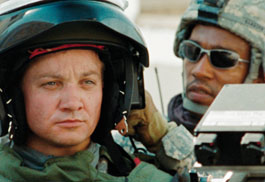home | metro silicon valley index | movies | current reviews | film review

Courtesy of Summit Entertainment
COMRADES IN ARMS: Jeremy Renner (left) and Anthony Mackie (right) search for the enemy in 'The Hurt Locker.'
Desert Pain
Kathryn Bigelow's 'The Hurt Locker' looks at war as a test of ability not politics
By Richard von Busack
THE HURT LOCKER" has been called the best movie about the Iraq war so far. It is certainly full of exciting qualities. One is the sharp, grimly funny script by co-producer Mark Boal, a former war correspondent who wrote the source story for In the Valley of Elah (which was called the best movie about Iraq back when it was released, come to think of it). Another is the magnetic performance by Jeremy Renner as Staff Sgt. William James, an inhumanly brave demolition expert. Director Kathryn Bigelow uses the essentially all-male cast to illustrate the concept of courage. She does what Howard Hawks would do. She takes the high road; she finds the cooperation between men of great competence in a killing trade, rather than pumping up rivalry like a Bruckheimer-era war-movie hack.
The soldiers of Bravo Company are stationed in Baghdad for the 2004 fighting. Central to the film is the mystery of James, who comes in to replace a slaughtered demolition expert. We know nothing about James except that he has a home life: troubled, but solid. James' risk-taking amazes and angers his subordinate, Sgt. Sanborn (Anthony Mackie). James remains insanely calm: going in to defuse a car bomb packed with explosive, he peels off the heavy flak-catching gear: "If I'm going to die, I'm going to die comfortable." Bigelow breaks through the sense of anonymity that characterizes most Iraq war movies, where helmeted men move alike and talk the same terse slang. (In such movies, if the cutting is quick enough, you really have to work to tell who is who.) By contrast, Bigelow expertly shifts through a series of nerve-wracking missions. In one, James unearths the trigger in a spider web of tripwires. In another, he tears apart a crafty car bomb trying to find the switch. The thrillingness of each particular mission is given very little camera adornment. During the rifle battle, because of the desert heat and vastness, Bigelow starts to stretch the skirmish into the surreal. She notes the acrobatic, ultraslow-motion of a tumbling spent rifle shell, the twisting of a dust devil.
Renner's side-cropped hair, his self-assuredness and the high-arched armor around his neck make us think of Henry V. The Hurt Locker takes a knightly view of the war, of men suiting up and closing their visors. Thus this is the first Iraq film an American audience can feel good about. The quality must have something to due with the film's popularity and praise. An absence of politics doesn't make a film apolitical, and that's why it's said that silence equals consent. The Hurt Locker's soldiers are in the right, fighting a defensive war against mad bombers. One final assignment, in the flaming ruins of a massive explosion, is certainly meant to recall the World Trade Center. The film's one line about how a bad experience with U.S. soldiers can turn a man insurgent is almost window dressing. Boal's script discovers the hollow inside the brave James: the missing part that made him never stop to realize why he did his job. That final revelation is smart filmmaking. It's just that the hollow inside this movie—inside almost all the war movies, even the good ones—isn't as easily seen. If war is a drug, as this movie claims, who's pushing it?
![]() THE HURT LOCKER (R; 131 min.), directed by Kathryn Bigelow, written by Mark Boal, photographed by Barry Ackroyd and starring Jeremy Renner and Anthony Mackie, plays at CinéArts Palo Alto and Santana Row.
THE HURT LOCKER (R; 131 min.), directed by Kathryn Bigelow, written by Mark Boal, photographed by Barry Ackroyd and starring Jeremy Renner and Anthony Mackie, plays at CinéArts Palo Alto and Santana Row.
Send a letter to the editor about this story.
|
|
|
|
|
|